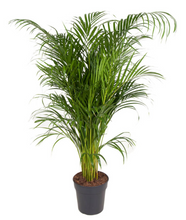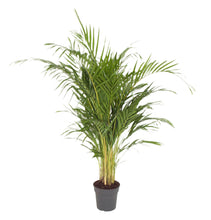Dypsis lutescens is part of the Arecaceae family and its native range is E. Madagascar. It is a clustering palm made up of many tufts, stems are yellow and topped with pinnate, arching, light-green leaves.
It is near threatened in its native habitat due to agriculture & aquaculture and biological resource use. (https://www.iucnredlist.org/species/195960/2436709)
Genus name may be related to the Greek dypto 'I dive' or dyptes 'diver'. Specific epithet comes from the Latin for ‘marshy, living in the marshes.’
Light: Bright indirect light, meaning the plant sees the sun for 0-4 hours per day - this could be through trees or a translucent curtain, it’s important for the plant to see the sky in order to thrive. South or west-facing windows with a curtain to prevent scorching.
Water: Allow the top 3 inches of potting mix to dry out, pour water slowly over the top and allow the water to pass through the drainage holes.
Potting mix: A well draining mix composed of coco coir, perlite or vermiculite, orchid bark and worm castings.
Fertilising: Feed your plant every other watering during the growing season or when you observe active growth. You can dilute fertiliser to half the recommended amount but never add more.
Temperature: 18-24˚C.
Humidity: Dypsis lutescens would prefer higher humidity (60% and above) but adapt well to average home humidity. You can increase humidity by placing the plant on a watered pebble tray or using a humidifier.
Dypsis lutescens is non-toxic.







